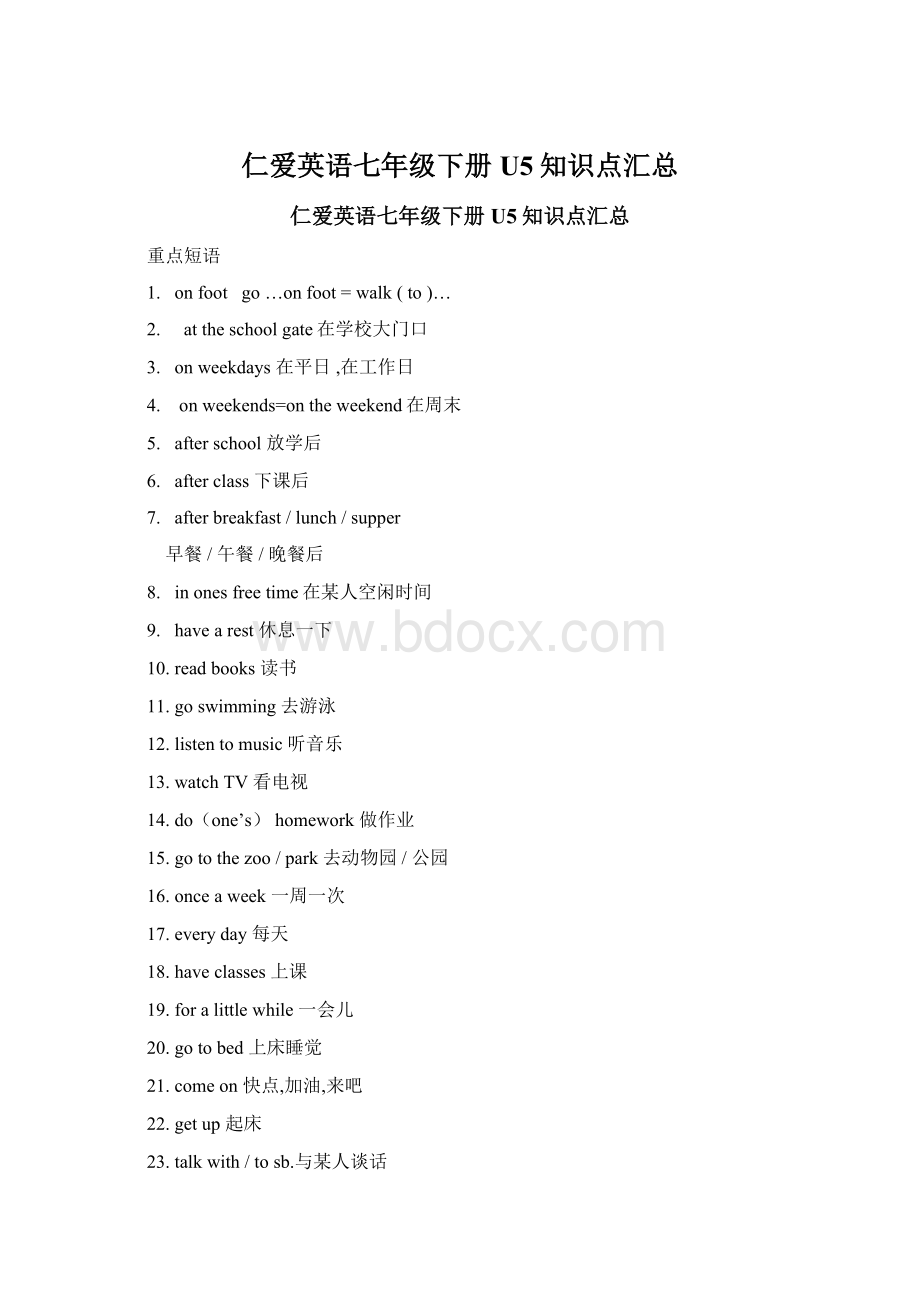仁爱英语七年级下册U5知识点汇总文档格式.docx
《仁爱英语七年级下册U5知识点汇总文档格式.docx》由会员分享,可在线阅读,更多相关《仁爱英语七年级下册U5知识点汇总文档格式.docx(15页珍藏版)》请在冰豆网上搜索。

上课
19.foralittlewhile
一会儿
20.gotobed
上床睡觉
21.comeon
快点,加油,来吧
22.getup
起床
23.talkwith/tosb.与某人谈话
24.atschool
在学校、在上课
25.gotoschool
去上学
26.andsoon……等等
重点句型
HappyNewYear!
Thesametoyou.
Yournewbikelooksverynice.
Thankyou.
Howdoyouusuallycometoschool?
—Iusuallycometoschoolbysubway.
Howoftendoyougotothelibrary?
—Once/Twice/Threetimesaweek/Veryoften/Everyday/Sedom
Theearlybirdcatchesthework.(谚语)
笨鸟先飞
Work/Studymustcomefirst.
工作/
学习必须放在第一位!
Classesbegin
ateight.=Classbeginsateight.
Whattimedoestheclassbegin?
/Whattimedotheclassesbegin?
10.Wehavenomoretime.
我们没有更多的时间了。
11.Ihavefourclassesinthemorningandtwointheafternoon.
我早上上四节课,下午上两节。
12.Shegoestobedataboutaquartertoten.
她九点四十五分睡觉。
重点详解
by+交通工具,表示使用某种交通方式,中间不加限定词,如果交通工具前有a,the,my
等限定词,就不能用by,而是用in或是on.
by+动词ing形式,表示通过某种方式乘坐交通工具
by+交通工具(bycar/bus/train/ship)
takethe+交通工具(takethebus/car)
on+大型封闭式工具(onthebus/train/ship/plane)
onthetrain=bytrain
onhisbike=bybikeonabike/motorbike
in+小型封闭交通工具(inacar/taxi)inmycar=bycar
Ialwayscometoschoolbybus.
Peopleshowlovetotheirmothersbygivingcards.
Youcanbeagoodstudentbyworkinghard.
巧辩异同 onfoot
与
walk
onfoot“走路”,是介词短语,不能作谓语,只作方式状语,位于句末。
walk“走路”,是动词,可以作谓语。
takethebus=go…bybus
rideabike=go…bybike
takethesubway=go…bysubway
goto…onfoot=walkto
Ioftengotoschoolonfoot.=Ioftenwalktoschool.
goto….bybike=rideabike
goto….bycar=driveacarto
goto…byplane=flyto
goto…bybus=takeabusto
It’stimeforsth.“该做某事了”
=It’stimetodosth.
It’stimeforclass.=It’stimetohaveclass.=It’stimeforhavingclass.
look+adj
(look感官动词,系动词)
看起来
Hismotherlooksveryyoung.
Theylookverycute.
Herdresslooksverynice.
Youlookverycoolinthiscoat.
look的短语
lookthesame看起来一样
looklike看起来像……
lookfor寻找
lookafter
=takecareof
照顾,照料
lookaround/about
四处看看,四下环顾;
lookback
回头看;
回顾;
lookout
当心,小心,留神;
lookthrough
浏览,仔细查看;
lookup
查寻,查阅;
抬头看
4.
doone’shomework
做家庭作业(注:
one’s
要随主语的变化而变化,常用形容词性物主代词my,your,their,our,his,her等)。
domyhomeworkatschool
在学校做作业
5.
wanttodosth.“想做某事”,want
后接动词不定式作宾语。
knowabout“了解,知道关于…”。
wewanttoknowabouttheschoollifeofAmericanstudents.
我们想了解一下美国学生的学校生活。
巧辩异同
afew+可数名词
(肯定);
一点,一些;
few+可数名词:
(否定)很少,几乎没有
alittle+不可数名词(肯定);
little
+不可数名词:
(否定)很少,几乎
little和few作形容词用,都表示“几乎没有”,强调少;
alittle和afew强调有一些。
e.g.Hehasafewfriends.
他有几个朋友。
Hehasfewfriends.
他几乎没有朋友。
e.g.IcanspeakonlyalittleChinese.
Theyhaslittlemoney.
他们没有什麽钱
alittle
也可以用作副词,表示“有点”“稍稍”
表示“很少”
e.g.CanyouspeakEnglish?
---Yes,butonlyalittle.
Thisbookisalittlemoredifficultthanthatone.
(可修饰形容词比较级)
Shesleptlittlelastnight.
昨天晚上,她没有怎么睡觉。
7.go+v.-ing
表示去做某事,类似:
gofishing
去钓鱼
goshopping
去买东西
goboating
去划船
goskating
去滑冰
goswimming
去游泳
andsoon“等等”,表示还有很多。
Theyoftenplaybasketballorcoccer,goswimmingandsoon.
(1).
Howoften
多久一次(对频度进行提问)
答语常用频度副词always>
usually>
often>
sometimes>
seldom>
never等或单位时间内的次数,表示频率的短语:
次数+单位时间
e.g.:
onceaweek一周一次
twiceamonth每月两次threetimesayear每年三次
你多久去一次图书馆?
--once/twice/threetimes/fourtimesaweek/month/year
(2).Howfar多远(表示距离)Howfarisitfromheretothezoo?
--It’s6kilometers.
(3).Howlong多长(对时间进行提问,持续多长时间(多久)/东西的长度(多长)
Howlongdidhestayhere?
Abouttwoweeks.
Howlongistheriver?
About500km.
(4).Howsoon再过多久,主要用来表示对将来一段时间的提问。
常用“in+时间段”来回答。
Howsoonwillhebeback?
Inanhour.
9.
over(形容词)
School/Classisover.
Whattimeistheclassover?
10.
begin
现在分词:
beginning
过去式:
began
begintodosth
begindoingsth
Hebeginstowritealetter.=Hebeginswritingaletter.
如果begin本身为分词,只能用begintodosth
Heisbeginningtorun.
11.
listento
听(动作),
hear
听见(结果)
冠词用法
弹乐器前要带定冠词the,而进行球类运动则不带the。
play+棋类/球类/牌
下……棋,打……球
playsoccer/basketball
playthe+西洋乐器
弹/拉……乐器
playtheguitar/piano
2.序数词,前面要用定冠词the。
onthesecondfloor
3.三餐前面不用冠词。
havebreakfast/lunch/supper
语法:
一般现在时
一般现在时表示:
(常与频度副词never,seldom,sometimes,often,usually,always等连用)
(1)现在所处的状态。
Janeisatschool.
(2)经常或习惯性的动作。
Ioftengotoschoolbybus.
(3)主语具备的性格和能力。
Helikesplayingfootball.
(4)客观真理。
Theearthgoesroundthesun.
常用的时间状语:
often,always,usually,sometimes,everyday等等。
行为动词的一般现在时,助动词是do/don’t和does/doesn’t.当主语是第一、二人称和所有复数形式时,行为动词用原形。
肯定式:
Igotoschoolonfoot.
否定式:
Idon’tgotoschoolonfoot.
疑问式:
Doyougotoschoolonfoot?
—Yes,Ido.—No,Idon’t.
当主语是第三人称单数时,动词用第三人称单数形式,在词尾加-s或-es。
Hegoestoworkbybus.
Hedoesn’tgotoworkbybus.
Doeshegotoworkbybus?
—Yes,hedoes.—No,hedoesn’t.
Unit5Topic2
重点短语:
1.makecards
制作卡片
on
theplayground
在操场上
in
thelibrary
在图书馆
thegym在体育馆
theshelf在书架上(shelves
复数)
at
theLostandFound
在失物招领处
7.cleantheroom打扫房间
8.have
asoccergame
举行足球比赛
9.have
an
Englishclass
上英语课
10.writealetter
写信
11.someofhisphotos
=somephotosof
his
他的一些照片
12.
ontime
准时/intime及时
13.dobetter
sth
在某方面做得较好
14.showsb.
around…
带领某人参观……
15.
atthemoment“此刻,现在”,=now.
16.planv.计划
plantodosth
17.bekind
to
sb
=befriendly
sb
对某人很友好
学科名词:
政治:
Politics
语文:
Chinese
数学:
Math
英语:
English
历史:
History
地理:
Geography
生物:
Biology
音乐:
Music
体育:
P.E
美术:
Art
一周名词:
星期一:
Monday
星期二:
Tuesday
星期三;
Wednesday
星期四;
Thursday
星期五:
Friday
星期六:
Saturday
星期日:
Sunday
1.Whatareyoudoing?
----
Heiscleaningthedormitory.
2.Areyoudoingyourhomework?
Yes,Iam./No,Iamnot.
3.HowlongcanIkeepthem?
Twoweeks.
4.Thankyou.---It’sapleasure.
=Apleasure=Mypleasure.
别客气。
5.Sorry,Idon’thaveany.
Thankyouallthesame.
仍然感谢你。
1.
①
gotobed“上床”“就寝”Ioftengotobedatten.
②
gotosleep“入睡”“睡着”LastnightIwenttosleepattwoo’clock.
3.
巧辩异同some,afew
与alittle“一些,有些”三者都修饰名词。
some既可以修饰可数名词又可以修饰不可数名词。
Wewantsomeapplesandsomewater.
afew用在可数名词复数之前
alittle用在不可数名词之前。
Thereareafewbooksandalittlewaterintheclassroom.
与how相关的短语
howoften多常 howmany多少
howmuch多少钱
howold多大
Andyoumustreturnthemontime.你必须按时归还它们。
Return意为“归还,回归
returnsth.tosb.把某物归还某人
=givebacksth.tosb.
returnto“回到…”,相当于comebackto…
talk“交谈”,常用的短语talkto/withsb.“与某人交谈”
Mariaandagirlaretalkingatthelostandfound.
巧辩异同talk,say,speak与tell
(1)
talk“交谈”,表示通过谈话方式交换意见、消息等。
(2)
speak“说话”,强调开口发声,后常接某种语言。
(3)
say
“说”,强调所说的话的内容。
(4)
tell“告诉”,有时兼含“嘱咐”“命令”等。
tellatruth说真话,tellalie说谎,
tellastory
讲故事等固定搭配。
7.lookfor“寻找”,强调寻找的过程;
find“找到”
发现,强调找的结果。
Ican’tfindmypurseandIamlookingforit.
Read,see,lookandwatch
look(at)
看,表动作,不及物动词,后面需加介词at才能跟宾语,指看的动作,
see
看见,指看的结果,
read常指看书、看报纸等,表示阅读
watch看比赛、电视
e.g
I
can
anappleonthetable。
Iwantto
thefilmwithyou。
,thereisakiteflyinginthesky。
Please
theblackboardcarefully。
Tvtoomuchisbadforyourhealth。
Herearesomephotosofhis.这有他的一些照片。
photosofhis是双重所有格。
his是名词性物主代词,后还可以接名词所有格。
afriendofmine我的一个朋友
aclassmateofmybrother’s我弟弟的一个同学
10.
巧辩异同
also与tooalso放在句中,too用于句末。
also意为“也”,常用于be动词和情态动词后面,实义动词的前面。
e.gHelenisalsoastudent.
Ihavelonghairandshehaslonghair,too。
borrow:
指主语借入
borrowsth.fromsb.
e.gYoucanborrowthisbookfromthelibrary.
MayIborrowyoureraser?
lend:
指主语借出
lendsth.tosb./lendsb.sth.
e.gCanyoulendyourcartome?
Theyoftenlendustheirball.
keep
和
borrow,lend
的意思一样,都是表示借的意思,
区别是borrow和lend是
瞬间动词/,短暂性动词,不能跟一段时间连用,而keep是延续性动词,表示借一段时间,
后常跟一段时间
e.gYoumaykeepthisbookfortwoweeks.
borrow借进
lend借出
keep借多久
14.
ontime:
准时,强调不早不迟到达
e.gWemustgotoworkontime.
intime:
及时,强调在规定的时间以前到达
Thestudentscangetthereintime.
15.
Japanese:
adj
日本的,日本人的,日语的
n.日本人,日语
当Japanese表示日本人时,是可数名词,单复数同形(与Chinese用法相同)
e.gTwoJapaneseandthreeChineseareswimmingintheswimmingpool.
重要句型总结
What’sin+sth
表示哪里有什么东西
e.gWhat’sinyourpurse?
钱包里有什么东西?
Whatelse
还有别的什么么?
else:
别的,其它的
Whatelsedoyouhave?
Whoelse还有别的什么人么?
Whereelse
还有别的什么地方么?
else除了可以放在疑问词what,who,where等后面,还可以放在不定代词something,anything,nothing,somebody,anybody,nobody后面
e.gIdon’thaveanythingelsetodo.
Ican’tseeanybodyelseintheroom.
Herearesomephotosofhis.
名词+Of+名词性物主代词/名词所有格----双重所有格
afriendof
Sam’s
萨姆的一个朋友
afriendofmine
我的一个朋友
lovedoingsth习惯性的爱好和习惯
lovetodosth一次性的动作或目前想做的事
e.gShelovesreadinginbed.
Ilovetogoswimmingtoday.
“Like+动词ing”表示“喜欢做某事”
Ilikeplayingbasketball.Tomlikeslisteningtomusic.
“Like+to+动词”也表示“喜欢做某事”,
只是“Like+动词ing”表示习惯性动作(也可以说是爱好),
而“Like+to+动词”表示一次性或短暂性的